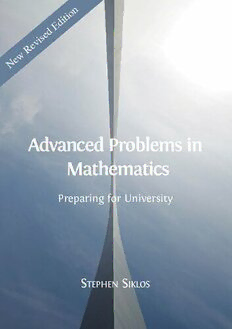
Advanced problems in mathematics : preparing for university PDF
Preview Advanced problems in mathematics : preparing for university
n o i t i d Advanced Problems in Mathematics E d e Preparing for University s i v e R Stephen Siklos w e N This new and expanded edi� on is intended to help candidates prepare for entrance examina� ons in mathema� cs and scien� fi c subjects, including STEP (Sixth Term Examina� on Paper). STEP is an examina� on used by Cambridge Colleges for condi� onal off ers in S mathema� cs. They are also used by some other UK universi� es and many mathema� cs t e departments recommend that their applicants prac� ce on the past papers even if they do p h not take the examina� on. e n Advanced Problems in Mathemati cs bridges the gap between school and university S i k mathema� cs, and prepares students for an undergraduate mathema� cs course. The l o ques� ons analysed in this book are all based on past STEP ques� ons and each ques� on s is followed by a comment and a full solu� on. The comments direct the reader’s a� en� on to key points and put the ques� on in its true mathema� cal context. The solu� ons point students to the methodology required to address advanced mathema� cal problems cri� cally Advanced Problems in and independently. A This book is a must read for any student wishing to apply to scien� fi c subjects at university d level and for anyone interested in advanced mathema� cs. v Mathematics a n c e Stephen Siklos was a fellow of Jesus College, Cambridge. He worked in d Cambridge University’s Faculty of Mathemati cs, where his main area of research P r was Einstein’s theory of general relati vity and where he acted as Admissions o b Offi cer. He had a parti cular interest in the transiti on from school to university l Preparing for University e mathemati cs and for over thirty years presided over the STEP examinati ons, m used as a qualifi cati on for undergraduate admissions by some of the top UK university s i mathemati cs departments. n M a As with all Open Book publica� ons, this en� re book is available to read for free on the t h publisher’s website. Printed and digital edi� ons, together with supplementary digital material, e m can also be found at www.openbookpublishers.com a t i c Cover image: Photograph by Logan Troxell on Unsplash at h� ps://unsplash.com/photos/DsQmBlbywJ8 s Cover design: Anna Ga� e book S S ebook and OA edi� ons TEPHEN IKLOS also available OPEN ACCESS OBP ADVANCED PROBLEMS IN MATHEMATICS Advanced Problems in Mathematics: Preparing for University Stephen Siklos http://www.openbookpublishers.com c 2019StephenSiklos. (cid:31) ThisworkislicensedunderaCreativeCommonsAttribution4.0Internationallicense(CCBY4.0). This license allows you to share, copy, distribute and transmit the work; to adapt the work and to make commercialuseoftheworkprovidingattributionismadetotheauthor(butnotinanywaythatsuggests thattheyendorseyouoryouruseofthework). Attributionshouldincludethefollowinginformation: StephenSiklos,AdvancedProblemsinMathematics: PreparingforUniversity. SecondEdition. Cambridge, UK:OpenBookPublishers,2019,https://doi.org/10.11647/OBP.0181 FurtherdetailsaboutCCBYlicensesareavailableathttp://creativecommons.org/licenses/by/4.0/ Anydigitalmaterialandresourcesassociatedwiththisvolumecanbefoundat https://www.openbookpublishers.com/product/1050#resources STEPquestionsreproducedbykindpermissionofCambridgeAssessmentGroupArchives.Pleasesend [email protected]. ThisisthesecondeditionofthefirstvolumeintheOBPSeriesinMathematics: ISSN2397-1126(Print) ISSN2397-1134(Online) ISBNPaperback: 9781783747764 ISBNDigital(PDF):9781783747771 DOI:10.11647/OBP.0181 Cover image: Photograph c Logan Troxell. Creative Commons Attribution International 4.0, CC BY. (cid:31) https://unsplash.com/photos/DsQmBlbywJ8. Coverdesign: AnnaGatti. Contents Aboutthisbook ix STEP 1 WorkedProblems 11 Workedproblem1 11 Workedproblem2 15 Problems 19 P1 Anintegerequation(1993PaperI) 19 P2 Partitionsof10and20(1997PaperI) 21 P3 Mathematicaldeduction(1994PaperI) 23 P4 Divisibility(1999PaperI) 25 P5 Themodulusfunction(1997PaperI) 27 P6 TheregularReuleauxheptagon(1987SpecimenPaperI) 29 P7 Chainofequations(1997PaperII) 31 P8 Trig. equations(1997PaperII) 33 P9 Integrationbysubstitution(1998PaperI) 35 P10 Trueorfalse(1998PaperI) 37 P11 Egyptianfractions(2000PaperII) 39 P12 Maximisingwithconstraints(1998PaperI) 41 P13 Binomialexpansion(1998PaperII) 43 P14 Sketchingsubsetsoftheplane(1999PaperI) 45 P15 Moresketchingsubsetsoftheplane(1995PaperI) 47 P16 Non-linearsimultaneousequations(1996PaperII) 49 P17 Inequalities(2001PaperI) 51 P18 Inequalitiesfromcubics(2001PaperI) 53 P19 Logarithms(2000PaperI) 55 P20 Cosmologicalmodels(2001PaperI) 57 P21 Meltingsnowballs(1991PaperI) 59 P22 Gregory’sseries(1991PaperII) 61 P23 Intersectionofellipses(2002PaperI) 63 P24 Sketchingxm(1(cid:0)x)n(2002PaperI) 65 vi AdvancedProblemsinMathematics P25 Inequalitiesbyareaestimates(2002PaperI) 67 P26 Simultaneousintegralequations(2002PaperI) 69 P27 Relationbetweencoefficientsofquarticforrealroots(1997PaperIII) 71 P28 Fermatnumbers(2002PaperII) 73 P29 Telescopingseries(1998PaperII) 75 P30 Integersolutionsofcubics(1998PaperII) 77 P31 Theharmonicseries(1999PaperI) 79 P32 Integrationbysubstitution(1999PaperII) 81 P33 Morecurvesketching(1999PaperII) 83 P34 Trig. sum(1999PaperII) 85 P35 Rootsofacubicequation(1999PaperIII) 87 P36 Rootcounting(1999PaperIII) 89 P37 Irrationalityofe(1997PaperIII) 91 P38 Discontinuousintegrands(2000PaperI) 93 P39 Adifficultintegral(1996PaperII) 95 P40 Estimatingthevalueofanintegral(2000PaperI) 97 P41 Integratingthemodulusfunction(2000PaperI) 99 P42 Geometry(2015PaperII) 101 P43 Thetsubstitution(2000PaperII) 103 P44 Adifferential-differenceequation(1990PaperII) 105 P45 Lagrange’sidentity(1987PaperII) 107 P46 Bernoullipolynomials(1987PaperIII) 109 P47 Vectorgeometry(2000PaperII) 111 P48 Solvingaquartic(2000PaperIII) 113 P49 Areasandvolumes(1987PaperII) 115 P50 Morecurvesketching(2001PaperII) 117 P51 Sphericalloaf(2001PaperI) 119 P52 Snowploughing(1987SpecimenPaperIII) 121 P53 Tortoiseandhare(1999PaperI) 123 P54 Howdidthechickencrosstheroad? (1997PaperI) 125 P55 Hank’sgoldmine(1998PaperI) 127 P56 Achocolateorange(1987SpecimenPaperII) 129 P57 Lorryonbend(2002PaperI) 131 P58 Fielding(1998PaperII) 133 P59 Equilibriumofrodofnon-uniformdensity(2002PaperII) 135 P60 Newton’scradle(1999PaperII) 137 P61 Kinematicsofrotatingtarget(1999PaperII) 139 P62 Particleonwedge(1998PaperII) 141 P63 Sphereonstep(1997PaperII) 143 StephenSiklos vii P64 Elasticbandoncylinder(2001PaperI) 145 P65 Aknock-outtournament(1987SpecimenPaperII) 147 P66 Harrythecalculatinghorse(1997PaperII) 149 P67 PINguessing(2002PaperI) 151 P68 Breakingplates(2001PaperI) 153 P69 Lottery(2001PaperII) 155 P70 Bodiesinthefridge(1987PaperII) 157 P71 Choosingkeys(2000PaperII) 159 P72 Commutingbytrain(2000PaperII) 161 P73 Collectingvoles(2000PaperII) 163 P74 Breakingastick(1999PaperII) 165 P75 Randomquadratics(1988PaperII) 167 Syllabus 169 About this book Thisbookhastwoaims. (cid:15) Thegeneralaimistohelpbridgethegapbetweenschoolanduniversitymathematics. Youmightwonderwhysuchagapexists. Thereasonisthatmathematicsistaughtatschoolfor variouspurposes: toimprovenumeracy;tohoneproblem-solvingskills;asaserviceforstudents goingontostudysubjectsthatrequiresomemathematicalskills(economics,biology,engineering, chemistry—thelistislong);and,finally,toprovideafoundationforthesmallnumberofstudents who will continue to a specialist mathematics degree. It is a very rare school that can achieve all this, and almost inevitably the course is least successful for its smallest constituency, future mathematicsundergraduates. (cid:15) ThemorespecificaimistohelpyoutoprepareforSTEPorotherexaminationsrequiredforuni- versityentranceinmathematics. TofindoutmoreaboutSTEP,readthenextsection. Itusedtobesaidthatmathematicsandcricketwerenotspectatorsports;thisisstilltrueofmathematics. To progress as a mathematician, you have to strengthen your mathematical muscles. It is not enough justtoreadbooksorattendlectures. Youhavetoworkonproblemsyourself. Onewayofachievingthefirstoftheaimssetoutaboveistoworkonthesecond,andthatishowthis bookisstructured. Itconsistsalmostentirelyofproblemsforyoutoworkon. The problems are all based on STEP questions. I chose the questions either because they are ‘nice’— in the sense that you should get a lot of pleasure from tackling them (I did), or because I felt I had somethinginterestingtosayaboutthem. The first two problems (the ‘worked problems’) are in a stream of consciousness format. They are in- tended to give you an idea of how a trained mathematician would think when tackling them. This approachismuchtoolong-windedtosustainfortheremainderofthebook, butitshouldhelpyouto seewhatsortofquestionsyououghttobeaskingyourselfasyouworkonthelaterproblems. Each subsequent problem occupies two pages. On the first page is the STEP question, followed by a comment.Thecommentsmaycontainhints,theymaydirectyourattentiontokeypoints,andtheymay includemoregeneraldiscussions. Onthenextpageisasolution;youhavetoturnover,sothatyoureye cannotaccidentallyfallonakeylineofworking. Thesolutionsgiveenoughworkingforyoutobeable toreadthemthroughandpickupatleastthegistofthemethod;theymaynotgiveallthedetailsofthe calculations. Foreachproblem, thegivensolutionisofcoursejustonewayofproducingtherequired result: theremaybemanyotherequallygoodorbetterways. Finally,ifthereisspaceonthepageafter the solution (which is sometimes not the case, especially if diagrams have to be fitted in), there is a postmortem. Thepostmortemsmayindicatewhataspectsofthesolutionyoushouldbereviewingand theymaytellyouabouttheideasbehindtheproblems. Ihopethatyouwillusethecommentsandsolutionsasspringboardsratherthanfeatherbeds. Youwill onlyreallybenefitfromthisbookifyouhaveagoodgoateachproblembeforelookingatthecomment and certainly before looking at the solution. The problems are chosen so that there is something for youtolearnfromeachone,andthiswillbelosttoyouforeverifyousimplyreadthesolutionwithout thinkingabouttheproblemonyourown.
